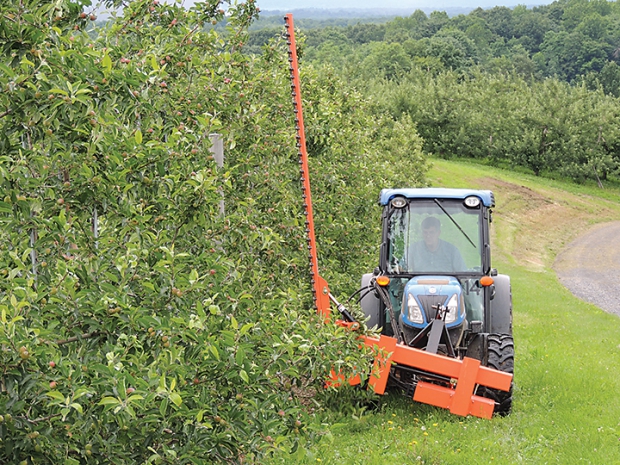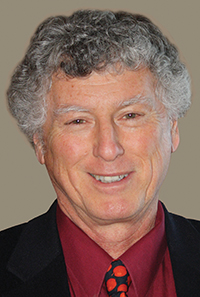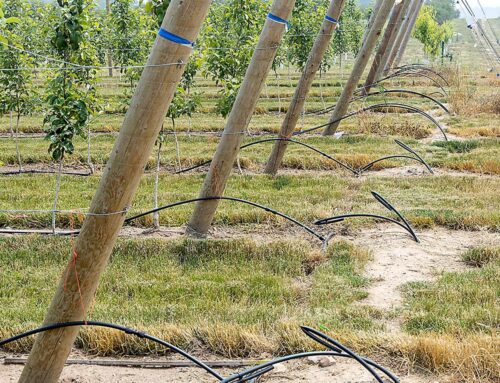In the last two years, apple growers have taken a lively interest in summer shearing, or sidewall mowing, to shape trees into fruiting walls.
The initial research was done in Italy by Dr. Alberto Dorigoni. This led to interest in the United States and research at New York’s Geneva Experiment Station by Cornell University’s Dr. Terence Robinson.
Demonstrations were held in apple orchards in New York and Michigan last year, where growers were enthusiastic about the potential of the technique.
But a Pennsylvania researcher warns growers south of New York, where trees grow more vigorously, that they might want to take a cautious approach. When he tried summer pruning back in the 1970s and 1980s, it didn’t work well at all with vigorous trees on semidwarfing rootstocks.
“This may not work if trees are vigorous.”
—Richard Marini
Dr. Richard Marini, who is now head of the Department of Plant Science at Pennsylvania State University but back then was a doctoral student at Virginia Tech, did a number of experiments on summer pruning in apples and peaches. He found that summer pruning in August had about the same effects as dormant pruning in March when the same types of pruning cuts were made. While it did help fruit develop more color, summer pruning also reduced fruit size as it affected the tree’s ability to photosynthesize carbohydrates in the final weeks before harvest.
Marini spoke to fruit growers during a session at the Mid-Atlantic Fruit and Vegetable Convention in Hershey, Pennsylvania, at the end of January.
The hypothesis
The hypothesis behind summer pruning, he said, is that removing leaves and shoots would reduce whole-tree photosynthesis, which would result in less stored carbohydrate, reducing reserves for spring growth. So the tree would be less vegetative the next year.
Also, the partial defoliation would allow better light penetration for improved fruit color and more flower bud development and fruit set.
The results were both supportive and not supportive of the hypothesis.
In the season of pruning, summer heading removed apical dominance and some buds below the heading cut did result in regrowth of short shoots.
But, on vigorous trees, the pruning resulted in less trunk and root growth, had no effect on shoot growth, had variable effect on flowering and fruit set, and did increase fruit color. Overall, the practice was not recommended.
“We did not see that summer pruning resulted in production of more terminal flower buds,” he said—something Dorigoni and Robinson say happened in their work with nonvigorous trees on dwarfing rootstocks.
In peaches, where trees were shorn over the top in August, it reduced trunk growth but not shoot growth, had no effect on flowering or fruit set, delayed defoliation and the onset of acclimation for winter hardiness, improved fruit red color, reduced fruit size and sweetness—and was not recommended as a grower practice.
Experiments with summer pruning are reported in scientific literature dating back to 1863, Marini said. There were spurts of research activity in 1900 to 1920, and again in the 1970s and 1980s. It never became standard grower practice.
Nonvigorous trees
Has something changed now?
Marini says that the work going on in New York is being done on nonvigorous tall spindle trees, and they may in fact respond differently. In Pennsylvania, apples trees are generally more vigorous than those in New York because of the milder climate and the longer growing season. And New York growers, in adopting high density planting, have moved toward dwarfing rootstocks that reduce tree vigor and change flowering habit.
Secondly, he said, the New York work is focused on labor reduction, and less on fruit size and accumulation of soluble solids. Summer pruning is being done to curtail dormant, detailed pruning, changing it from an every-year process to a once-every-three-years process.
In the New York research in 2012 and 2013, pruning cost and time using the hedger was only 5 percent as much as would be required for manual summer pruning, Marini said.
Thirdly, “Weak shoots seem to respond differently than vigorous shoots to the summer shearing process,” he said. They may produce fewer vegetative shoots below the heading cuts, less regrowth in the summer and less shoot growth the following year, and better flower bud initiation.
Depending on the timing, summer shearing cut off only 22 to 38 percent of the growing points on the tree, Marini said, reviewing the New York findings. Sidewall shearing in June, July, or August removed 4 to 6 percent of the fruits in the New York tests and resulted in a regrowth response of 4 to 6 inches, where most of the short regrowth shoots resulted in a terminal flower bud.
There was very little change in yield, fruit quality, or crop value in the New York trials.
“This may not work if trees are vigorous,” Marini said.
While he advised Mid-Atlantic growers to “keep an eye on the New York research,” he advised them against trying it on vigorous trees—and to keep in mind the risk of fireblight in making cuts on shoots outside of the dormant pruning season. •








Leave A Comment